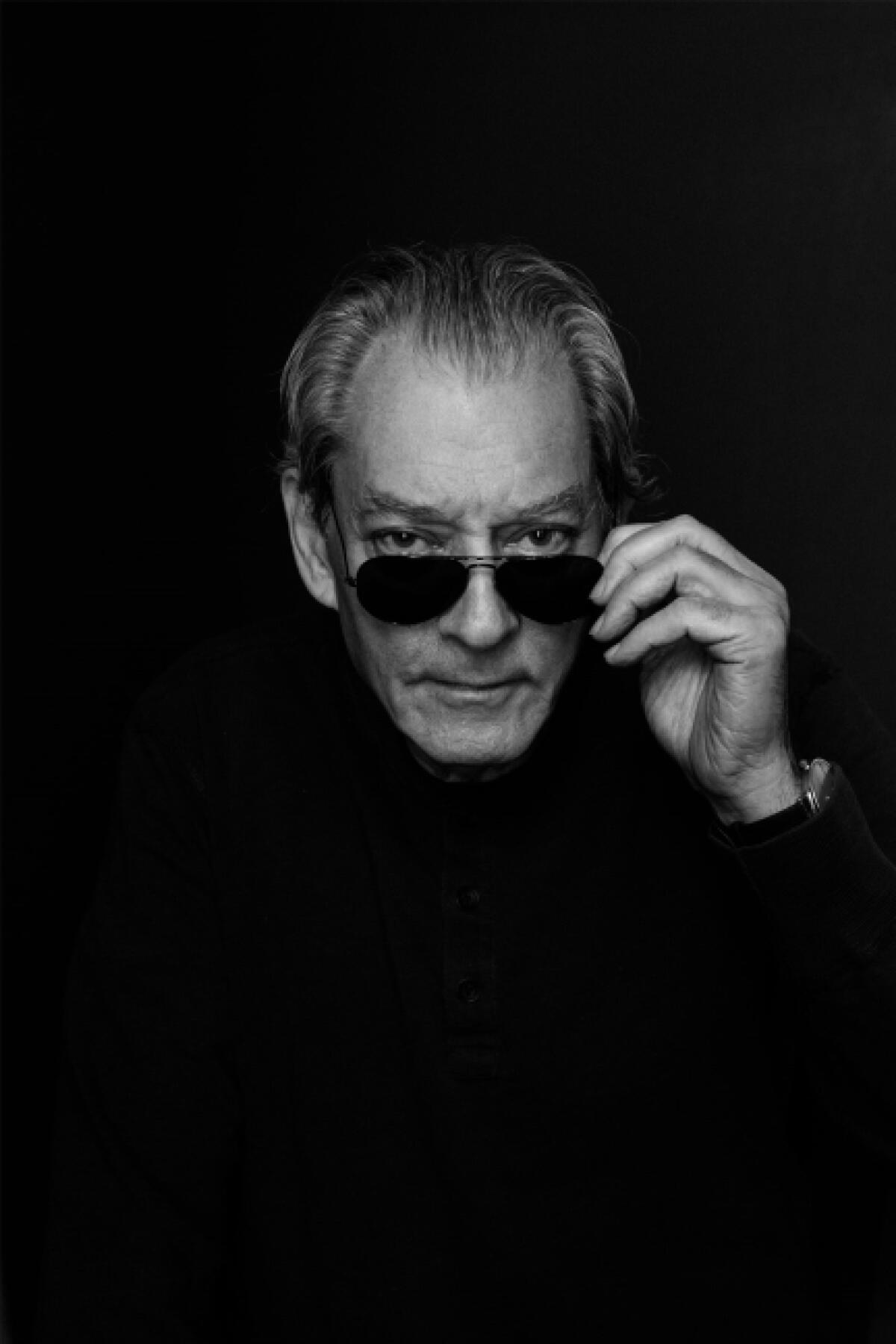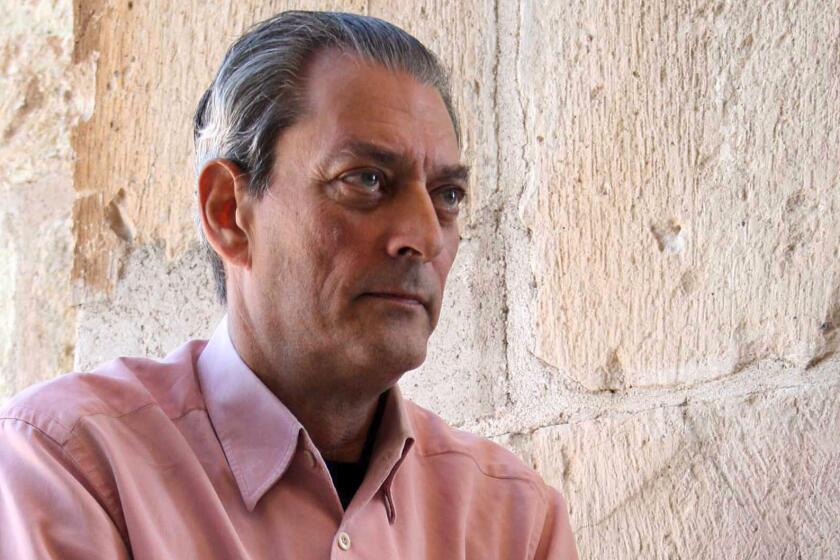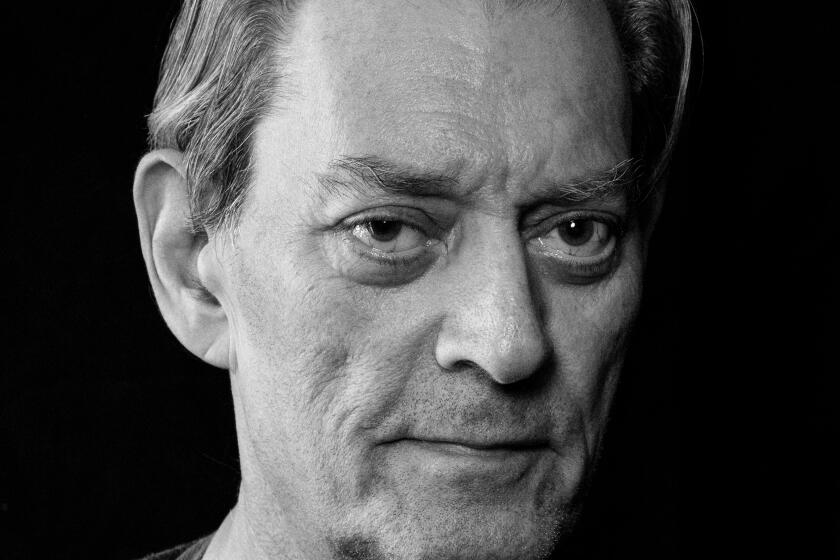Paul Auster, postmodern author behind ‘The New York Trilogy’ and ‘Smoke,’ dies at 77

- Share via
Paul Auster, the bestselling postmodern author, noir novelist and screenwriter behind “Smoke,” “Lulu on the Bridge” and “The Inner Life of Martin Frost,” has died. He was 77.
“The New York Trilogy” and “4 3 2 1” author’s death was confirmed Wednesday by his literary representatives at Carol Mann Agency, according to the Associated Press. No details about his death were given and representatives for the agency did not immediately respond Wednesday to The Times’ request for comment.
The New York Times reported that Auster died Tuesday evening at his home in Brooklyn from complications of lung cancer. The writer had been diagnosed with cancer in 2022.
Auster, who also enjoyed a rich career as a poet and memoirist, became a fixture of the Brooklyn literary scene. He was known for his “metafiction” and for drawing attention to the artifice of storytelling. Although his commercial success in the United States was modest, he was deeply admired abroad and he was awarded several prizes during his prolific career, including the Prince of Asturias Award for Literature, the Prix Médicis étranger, an Independent Spirit Award and the Premio Napoli. He was also a member of the American Academy of Arts and Letters, the American Academy of Arts and Sciences and was a Commandeur de l’Ordre des Arts et des Lettres.
A long novel is something thought to be a serious novel.
“Listen, money’s important. Everyone cares about money. And when you don’t have money, money becomes the overriding obsession of your life,” he said on the “Bat Segundo Show” in 2008. “I wrote a whole book about that … ‘Hand to Mouth.’ And the only good thing about making money is that you don’t have to think about money. It’s the only value. Because if you don’t have it, you’re crushed. And for a long period in my life, I was crushed.”
Referred to as “the dean of American postmodernists” and “the most meta of American meta-fictional writers,” Auster’s body of work boasted more than 30 books since he began publishing in the 1970s. He crafted fiction that hinged on reality but also challenged the definition of it. His breakthrough 1985 novel, “City of Glass,” combined hard-boiled detective fiction with existential inquiry and featured a character called Paul Auster. Its 1986 follow-ups, “Ghosts” and “The Locked Room,” comprised Auster’s famed “New York Trilogy.” His 1994 fable, “Mr. Vertigo,” featured literal flights of fancy; and his 2008 work “Man in the Dark” created dreamscapes that conjured parallel visions of modern-day America, according to Times contributor Malcolm Forbes.
Since his breakthrough novel ‘City of Glass,’ Paul Auster has been known for postmodern trickery. His latest, ‘Baumgartner,’ succeeds through its simplicity.
His work imposed a sense of irreality on his readers, and his oeuvre was replete with writers and themes revolving around the elusiveness of human nature and the insufficiency of language to investigate the matter, according to one Times review.
“You’re just somehow in what the words are saying,” he told KQED in 2009, “but you’re not even thinking about the words anymore.”
Paul Benjamin Auster was born on Feb. 3, 1947, in Newark, N.J., and grew up in a middle-class Jewish home. His father was a miserly penny-pincher and his mother, who was about 13 years younger, was a spender. The marriage ultimately ended in divorce. Auster’s uncle, translator Allen Mandelbaum, left several boxes of books in storage for his nephew to read while he traveled to Europe and young Auster developed an interest in writing, literature and poetry.
Auster once joked that he became a writer after a fateful meeting with baseball great Willie Mays as a young boy. After missing out on getting Mays’ autograph because he didn’t have a pencil, the future scribe said he always made sure to keep a pencil or pen in his pocket “because I didn’t want to be caught unprepared again.” He famously worked without a computer, preferring to write with a typewriter and stay off the internet to avoid emails.
This article was originally on a blog post platform and may be missing photos, graphics or links.
In his early 20s, short-form writing like poems came easily to him but he struggled with longer work. He published his first book, a collection of poems titled “White Spaces,” in 1980, and followed it up with his first memoir in 1982, “The Invention of Solitude,” which reflected on his father’s death. In an interview with Louisiana Channel, he said he must have written 1,500 pages of aborted novels and manuscripts, which he considered his apprenticeship in “how to put sentences together.” Writing became “instinctive” over time, but he never considered himself a fast writer. He believed that a good day of work could produce one typed page — “two pages is great, three is a miracle” that happens four times a year.
“The hard work is in trying to make it look easy,” he said.
His longest and most ambitious work of fiction was his 866-page novel “4 3 2 1,” which was published in 2017 and was a finalist for the Booker Prize. Although not traditionally a writer of “doorstoppers,” Auster’s book told the story of Archie Ferguson, a character mirroring the author himself in a four-part narrative. It catalogs the ordinary existence of four parallel Fergusons in the post-World War II era in exhaustive detail, imagining each version’s shifting fate based on differing circumstances.
Auster’s other works included the nonfiction compilations “Groundwork” and “Talking to Strangers”; a family memoir, “The Invention of Solitude”; the novel “Leviathan”; and the poetry collection “White Spaces.” In 2021, he chronicled the life and work of 19th century author Stephen Crane in “Burning Boy.” His most recent novel, 2023’s “Baumgartner,” told the story of a widowed professor haunted by mortality and was considered a late-career triumph that cut back on his usual “postmodern pyrotechnics.”
Several of his works, including his 1990 novel “The Music of Chance,” were adapted for the screen and Auster was behind the camera for a number of them. Harvey Keitel starred in the 1995 drama “Smoke,” about a Brooklyn cigar store and its various patrons played by William Hurt and Giancarlo Esposito. Working as a screenwriter, Auster embellished his short story that originally appeared as a Christmas Day op-ed in the New York Times, employing “the film medium as an extension of his literary art,” according to the Los Angeles Times’ review. The film won him the Independent Spirit Award for first screenplay.
He re-teamed with “Smoke” director Wayne Wang later that year and they co-directed the sequel, “Blue in the Face,” which brought back Keitel and Esposito and also starred Lou Reed, Mira Sorvino and Madonna. He is also credited on the screenplay for Wang’s 2001 romance “The Center of the World.”
Auster wrote and directed the 1998 mystery drama “Lulu on the Bridge,” which again starred Keitel and Sorvino and was nominated for the Un Certain Regard prize at the Cannes International Film Festival. He wrote and directed the 2007 comedy “The Inner Life of Martin Frost,” which explored the art of writing and starred David Thewlis, Irène Jacob and Michael Imperioli.
Auster is survived by his wife, fellow author Siri Hustvedt, and daughter Sophie. His son Daniel Auster, whom he had from an earlier marriage, died from a drug overdose in 2022 after struggling with drug addiction and after being charged with second-degree manslaughter of his infant daughter.
The Associated Press contributed to this report.
More to Read
Sign up for our Book Club newsletter
Get the latest news, events and more from the Los Angeles Times Book Club, and help us get L.A. reading and talking.
You may occasionally receive promotional content from the Los Angeles Times.












